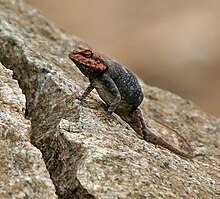Blanford's rock agama (Psammophilus blanfordanus) is species of lizard in the family Agamidae. The species is endemic to Peninsular India. One of two species in the genus, P. blanfordanus is found mainly to the east of the distribution of P. dorsalis. Unlike the other species, the male P. blanfordanus in breeding season has the red body color restricted to the head and lacks the broad dorsal stripe.
| Blanford's rock agama | |
|---|---|

| |
| Psammophis blanfordanus, in Hyderabad, Andhra Pradesh, India | |
| Scientific classification | |
| Domain: | Eukaryota |
| Kingdom: | Animalia |
| Phylum: | Chordata |
| Class: | Reptilia |
| Order: | Squamata |
| Suborder: | Iguania |
| Family: | Agamidae |
| Genus: | Psammophilus |
| Species: | P. blanfordanus
|
| Binomial name | |
| Psammophilus blanfordanus | |
| Synonyms[3] | |
| |
Etymology
editBoth the specific name, blanfordanus, and the common name, Blanford's rock agama, are in honor of English naturalist William Thomas Blanford (1832–1905), member of the Geological Survey of India.[4]
Description
editAlthough very similar to P. dorsalis, a specimen of P. blanfordanus can be separated by several features. P. blanfordanus has a deeper fold on the front of the humerus. The scales on the body are a little larger, and number from 80 to 100 round the middle of the body. The dorsal scales appear keeled and imbricated. When the hind leg is stretched forward and held along the body, it reaches the eye or extends beyond it. Often, a small spine is found behind the edge of the brow-ridge of the eye, and a few enlarged scales are scattered on the sides. Young lizards are olive-brown above, spotted or marbled with brown very similar to the female, but often have a series of large, lozenge-shaped, dark brown spots with pale centres on the back and tail. The adult male is much like P. dorsalis, but in the summer breeding season, the head and anterior part of the body of the males become scarlet or red while the posterior parts are nearly black.
P. blanfordanus is found mainly on rocks. The male displays by head nodding.[5]
Snout-to-vent length (SVL) is about 10 cm (3.9 in), and the tail is about 20 cm (7.9 in) long. Females are slightly smaller than males.[5]
Behaviour
editP. blanfordanus spends most of its time resting or basking under the sun. Excess heat causes it to rest inside water holes to decrease overall body temperature.[citation needed]
Diet
editReproduction
editDistribution
editP. blanfordanus is common on many of the hills from Chota Nagpur, as high as Parasnath Hill to 4,500 feet (1,400 m), Madhya Pradesh and extending south along the Godavari Districts, hills of the Eastern Ghats. The southernmost record appears to be Talayar in Travancore, where a specimen was collected by Harold S. Ferguson at 7,000 feet (2,100 m).[6]
References
edit- ^ a b Srinivasulu C, Srinivasulu B, Sreekar R, Mohapatra P, Murthy BH (2013). "Psammophilus blanfordanus ". IUCN Red List of Threatened Species. 2013: e.T172604A1350372. doi:10.2305/IUCN.UK.2013-1.RLTS.T172604A1350372.en. Retrieved 13 May 2021.
- ^ Stoliczka F (1871). "Notes on new or little known Indian Lizards". Proc. Asiatic Soc. Bengal 1871:192–195. (Charasia blanfordana, new species, p. 194).
- ^ a b Species Psammophilus blanfordanus at The Reptile Database www.reptile-database.org.
- ^ Beolens B, Watkins M, Grayson M (2011). The Eponym Dictionary of Reptiles. Baltimore: Johns Hopkins University Press. xiii + 296 pp. ISBN 978-1-4214-0135-5. (Psammophilus blanfordanus, p. 27).
- ^ a b Smith MA (1935). The Fauna of British India, Including Ceylon and Burma. Reptilia and Amphibia. Vol. II.—Sauria. London: Secretary of State for India in Council. (Taylor and Francis, printers). xiii + 440 pp. + Plate I + 2 maps. (Psammophilus blanfordanus, new combination, p. 210).
- ^ Boulenger GA (1891). "Description of a New Species of Lizard obtained by Mr. H. S. Ferguson in Travancore, Southern India". Journal of the Bombay Natural History Society 6 (4): 449. (Lygosoma subcæruleum, new species).
Further reading
edit- Boulenger GA (1885). Catalogue of the Lizards in the British Museum (Natural History). Second Edition. Volume I. ... Agamidæ. London: Trustees of the British Museum (Natural History). (Taylor and Francis, printers). xii + 436 pp. + Plates I-XXXII. ("Charasia blanfordiana [sic]", pp. 333–334).
- Boulenger GA (1890). The Fauna of British India, Including Ceylon and Burma. Reptilia and Batrachia. London: Secretary of State for India in Council. (Taylor and Francis, printers). xviii + 541 pp. ("Charasia blanfordiana [sic]", p. 145).
